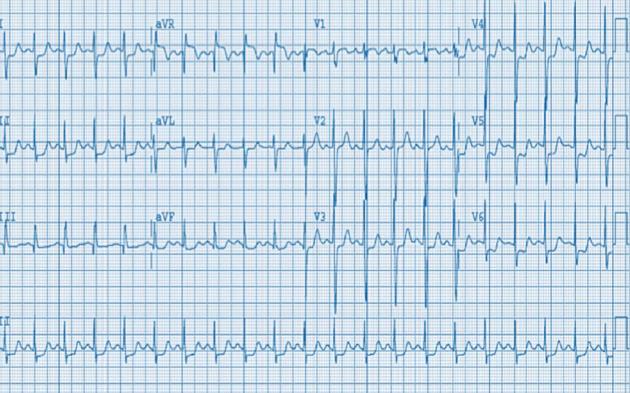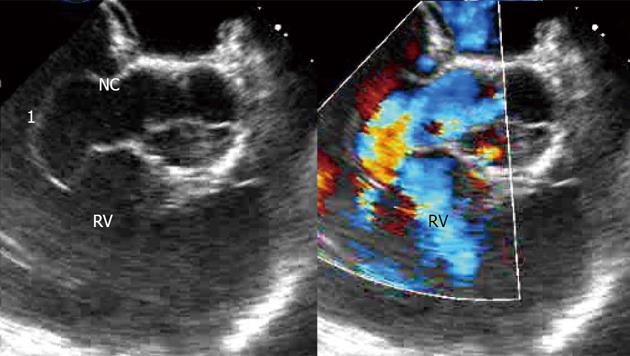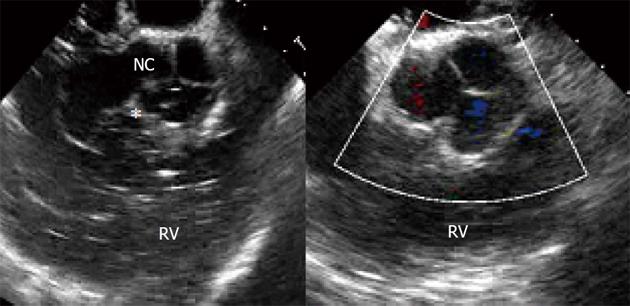Published online Jul 16, 2013. doi: 10.12998/wjcc.v1.i4.146
Revised: May 14, 2013
Accepted: June 1, 2013
Published online: July 16, 2013
Processing time: 161 Days and 12.3 Hours
Ruptured sinus of Valsalva is very uncommon, and is < 1% of all congenital defects. The incidence ranges from 0.1%-3.5%. There is a male to female predominance of 4:1, with the highest incidence in the Asian population. Higher incidence is also seen in patients with Marfan’s syndrome and Ehlers Danlos syndrome. There is a higher association of ruptured sinus of Valsalva with ventricular septal defect (VSD), aortic stenosis, and bicuspid valve defect. While most patients with VSD often have rupture of their right coronary sinus of Valsalva into the right ventricle due to poor structural integrity, we present a rare case of a patient with VSD who had rupture of his noncoronary sinus of Valsalva into the right atrium.
Core tip: It is important to understand that aneurysms and or rupture of the coronary sinus of Valsalva can occur from any sinus and into any chamber, which will affect management and treatment.
- Citation: Cao LB, Hannon D, Movahed A. Noncoronary sinus of Valsalva rupture into the right atrium with a coexisting perimembranous ventricular septal defect. World J Clin Cases 2013; 1(4): 146-148
- URL: https://www.wjgnet.com/2307-8960/full/v1/i4/146.htm
- DOI: https://dx.doi.org/10.12998/wjcc.v1.i4.146
Ruptured sinus of Valsalva is very uncommon, and is < 1% of all congenital defects. The incidence ranges from 0.1%-3.5%. There is a male to female predominance of 4:1, with the highest incidence in the Asian population. Higher incidence is also seen in patients with Marfan’s syndrome and Ehlers Danlos syndrome. There is a higher association of ruptured sinus of Valsalva with ventricular septal defect (VSD), aortic stenosis, and bicuspid valve defect. Sinus of Valsalva aneurysm is commonly seen in patient ages 13 to 65-year-old with a mean age of 35 years. Rupture often occurs before the age of 40 and after puberty[1]. The frequency at which the right coronary sinus of Valsalva ruptures is approximately 75% in comparison to the noncoronary cusp, which is approximately 20% and rarely does the left coronary cusp rupture[2]. Typically, sinus of Valsalva aneurysms involve the right ventricle 60% of the time, the right atrium approximately 30% of the time and less than 10% of the time with the left atrium, left ventricle or pericardium combined[3].
Structural defects often lead to lack of continuity between the aortic media and the aortic annulus leading to subsequent weakening, avulsion and aneurismal formation. Congenitally, there may be incomplete fusion of the right and left distal bulbous septum, the base of which forms the right and the non coronary sinuses of Valsalva. Acquired causes often involve severe infections with syphilis and or endocarditis, trauma, severe atherosclerosis and aortic dissection that alter the anatomy and structural integrity of the sinuses leading to aneurismal formations[4].
A 20-year-old man with documented history of VSD presents to the Emergency Department with symptoms of nausea and vomiting. Patient had denied chest pain, but admits to shortness of breath and fatigue. He was sweaty, and diaphoretic. His heart rate was 124; blood pressure was 117/33 mmHg, he was tachypnic and saturating on room air at 88%. He had a continuous murmur on exam, with jugular venous distention. His lab results show an elevated white count of 13, creatinine of 1.65, troponin of 1.70 and lactic acid of 3.80, with normal liver enzymes. Chest X-rays shows bilateral lung congestion without cardiomegaly. Electrocardiogram shows sinus tachycardia with a rate of 130, 1 mm to 3 mm ST depressions in leads I, II, and V3 to V6 and 1 mm to 2 mm ST elevations in aVR and V1 (Figure 1).
Transthoracic echocardiogram initially done showed a poorly visualized echogenic flap in the right atrium. Subsequent transesophageal echocardiogram done, showed a ruptured aneurysm of the noncoronary sinus of Valsalva, that is Windsock in morphology, into the right atrium (Figure 2). Coincidentally, IV medications given during the echocardiogram had micro air bubbles that transiently traveled through the small membranous VSD communicating with the right coronary sinus of Valsalva (Figure 2). Continuous flow through a relatively low pressure right atrium prevented the micro air bubbles from entering the aortic root through the rupture lumen, yet higher pressures in the right ventricle allowed for the micro air bubbles to travel through the VSD. Patient underwent immediately surgery to repair both the ruptured aneurysm of the noncoronary sinus of Valsalva and the VSD (Figure 3).
What makes our case unique is that the non coronary sinus of Valsalva rarely ruptures into the right atrium in the presence of a perimembranous septal defect. In the largest retrospective analysis of a rupture of sinus of Vasalva (n = 67) done by Dong et al[5], only 18/32 (56%) of the patients had perimembranous VSD with rupture, and among this group, only 1 of the 32 patients presented with a “non coronary sinus of Valsalva rupture” in the presence of perimembranous VSD. Our patient also had a unique wind-sock aneurysmal morphology to his non coronary sinus of Valsalva rupture.
The gold standard for diagnosis is echocardiogram. The treatment of choice is surgery, which has a 90% ten year survival rate with closure of aneurysm and perimembranous VSD[6]. Percutaneous intervention with an Amplatzer Duct Occluder has been found to be successful in selective cases and has been utilized in Europe[7].
P- Reviewers Lai V, Manfredini R S- Editor Gou SX L- Editor A E- Editor Yan JL
| 1. | Takach TJ, Reul GJ, Duncan JM, Cooley DA, Livesay JJ, Ott DA, Frazier OH. Sinus of Valsalva aneurysm or fistula: management and outcome. Ann Thorac Surg. 1999;68:1573-1577. [RCA] [PubMed] [DOI] [Full Text] [Cited by in Crossref: 212] [Cited by in RCA: 213] [Article Influence: 8.2] [Reference Citation Analysis (1)] |
| 2. | Fishbein MC, Obma R, Roberts WC. Unruptured sinus of Valsalva aneurysm. Am J Cardiol. 1975;35:918-922. [RCA] [PubMed] [DOI] [Full Text] [Cited by in Crossref: 81] [Cited by in RCA: 75] [Article Influence: 1.5] [Reference Citation Analysis (0)] |
| 3. | Ott DA. Aneurysm of the sinus of valsalva. Semin Thorac Cardiovasc Surg Pediatr Card Surg Annu. 2006;165-176. [RCA] [PubMed] [DOI] [Full Text] [Cited by in Crossref: 73] [Cited by in RCA: 88] [Article Influence: 4.6] [Reference Citation Analysis (0)] |
| 4. | Edwards JE, Burchell HB. Specimen exhibiting the essential lesion in aneurysm of the aortic sinus. Proc Staff Meet Mayo Clin. 1956;31:407-412. [PubMed] |
| 5. | Dong C, Wu QY, Tang Y. Ruptured sinus of valsalva aneurysm: a Beijing experience. Ann Thorac Surg. 2002;74:1621-1624. [RCA] [PubMed] [DOI] [Full Text] [Cited by in Crossref: 61] [Cited by in RCA: 62] [Article Influence: 2.7] [Reference Citation Analysis (0)] |
| 6. | van Son JA, Danielson GK, Schaff HV, Orszulak TA, Edwards WD, Seward JB. Long-term outcome of surgical repair of ruptured sinus of Valsalva aneurysm. Circulation. 1994;90:II20-II29. [PubMed] |
| 7. | Kerkar PG, Lanjewar CP, Mishra N, Nyayadhish P, Mammen I. Transcatheter closure of ruptured sinus of Valsalva aneurysm using the Amplatzer duct occluder: immediate results and mid-term follow-up. Eur Heart J. 2010;31:2881-2887. [RCA] [PubMed] [DOI] [Full Text] [Cited by in Crossref: 51] [Cited by in RCA: 60] [Article Influence: 4.0] [Reference Citation Analysis (1)] |















